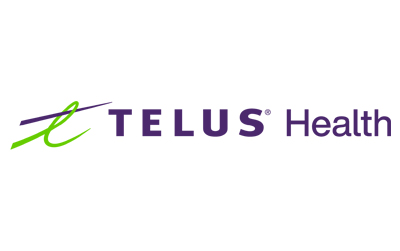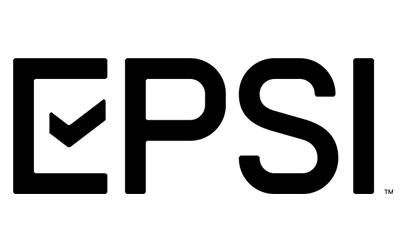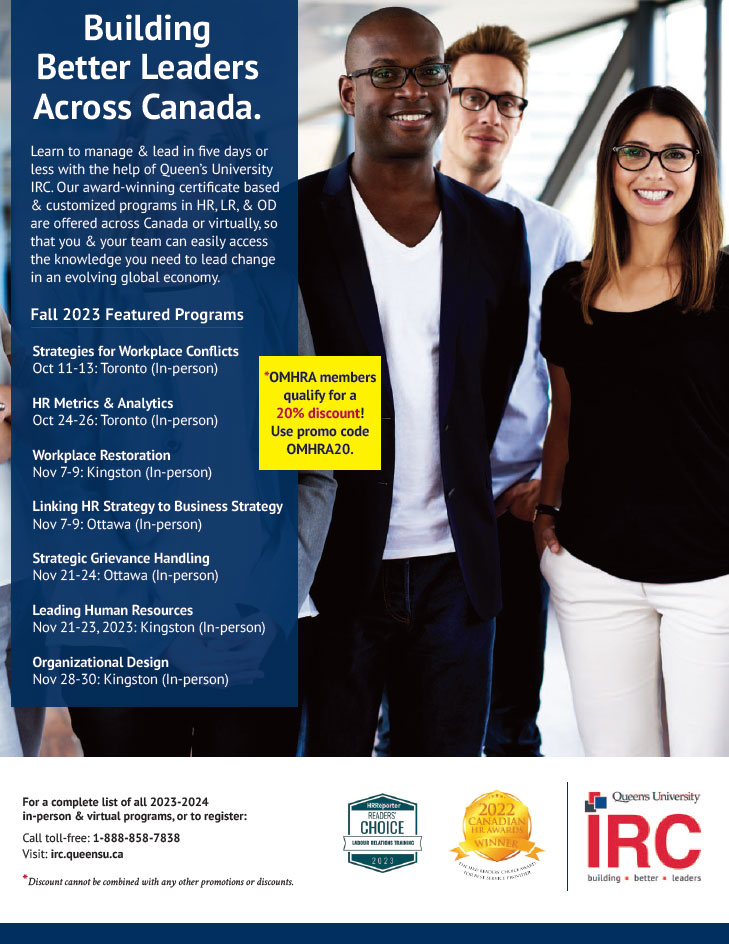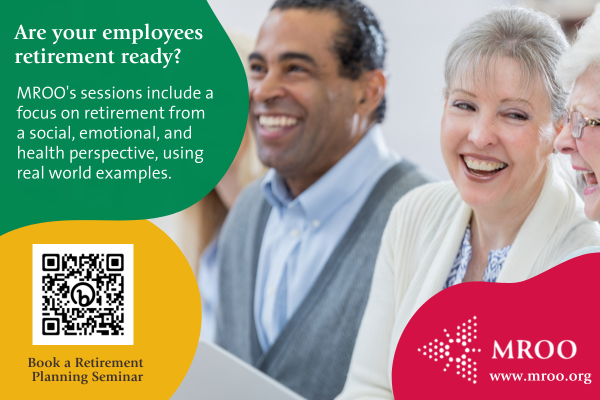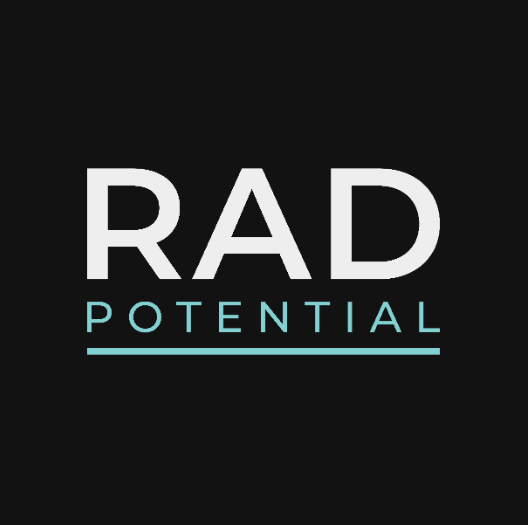
Issue #6 – AUGUST 2023
HR Navigator is published the last Friday of each month

In this month’s newsletter we are exploring the topic of retention, which is one of the biggest challenges we face as H.R. professionals. Many of our long-serving employees are retiring from the workforce, taking with them the knowledge accumulated over the course of their careers. We need to figure out how to increase retention and better facilitate corporate knowledge retention and knowledge transfer.
A mentoring program is one way to impart corporate knowledge to others and to let employees explore different areas of the corporation. This type of program helps connect staff that would not normally cross paths. The positive feedback we received to this program in my municipality has been overwhelming.
All of us are trying to think of new and different ways to increase retention. Sometimes the task seems daunting and a bit overwhelming. Employee engagement surveys, if done correctly, can help us get a sense of what is working in an organization and what isn’t.
The workforce has changed so drastically from when I started. It seems that now, if an employee is unhappy, they just leave. It is a totally different culture and one we need to try to understand and adapt to – the sad fact is that sometimes there is nothing we can do to keep an employee.
One of our strengths of our association is that it provides a venue and a vehicle for us to share our experiences, ideas, and yes, frustrations. It’s also a source of professional and emotional support; we can tell each other our crazy (and of course, anonymous) stories about why employees are leaving. You can’t make this stuff up! Some of the exit interviews read like a good book!
Enjoy the ideas and insights in this month’s newsletter and keep laughing everyone. I can’t wait to talk to you about this in person at our conference in September!

Lori Bolton, President

How employee engagement can help reduce turnover and drive retention
Employee retention is so much more than just a metric. It’s a testament to people’s feeling of commitment, engagement, and enjoyment when it comes to their work. As a result, high levels of employee retention can signal a strong business and company culture.
For many employers, turnover remains a considerable challenge. In 2022, 35% of hiring decisions-makers reported higher turnover rates — a 9% increase from 2021 — and in a recent Robert Half survey of the workforce, half of those who responded expressed their intention to look for new employment opportunities in the year ahead.
Here’s a more detailed look at what’s driving this changeover in the workforce, and what companies can do to keep their talent happy.
Employee turnover costs companies in more ways than one.
When employees leave, it’s a loss for employers and employees alike. The loss of an employee leaves a hole in the team that their co-workers might have to fill before a replacement can be found, which detracts from their own job satisfaction and impacts their work/life balance.
But the most immediately noticeable and measurable costs are monetary. According to one survey, lost productivity, subsequent recruitment initiatives, and other inefficiencies and expenditures related to turnover total an average of $41,000 per year, though this can range significantly based on the size and specific circumstances of the business.
To counter the adverse effects of employee loss, there are actionable steps organizations can take to help increase their rates of employee retention.
Keeping your talent means keeping your talent happy.
A survey of human resources professionals shows that 86% believe providing better mental health support for employees can improve retention. At the same time, 88% and 76% see it as an effective way to bolster productivity and organizational return on investment, respectively.
And they’re right. Stress and anxiety have been on the rise in recent years due to circumstances beyond people’s control, such as the pandemic, geopolitical instability, and the rising cost of living.
Employers are taking note, too. Research conducted in 2020 showed that 95% of organizations surveyed were committed to maintaining or increasing their employee health and wellbeing initiatives over the next five years, while 4 out of 10 employers considered digital health benefits to be an important part of their retention strategies.
Such benefits provide two important incentives for employees to stay with their organization. They empower employees to connect with medical professionals to help address their mental health concerns, while the on-demand flexibility of digital health services contributes to a better work-life balance, which continues to be a top priority for the workforce.
A healthier lifestyle takes centre stage for the workforce.
Just how important is work-life balance for employees? One study shows that 58% consider it more important than financial compensation. Another 35% would prefer mental health benefits to higher pay or salary. And 28% place the highest value on ancillary services related to wellness, such as yoga and mediation.
Salary remains critical, of course, especially with inflation and the increasing cost of living. Data from Robert Half shows that 78% of workers cited salary as the dominant reason for accepting one job offer over another. Yet for almost half of respondents, benefits were also a top factor determining their decision.
All of this research demonstrates that when it comes to retention, companies would do well to focus on holistic support for employee health and wellbeing.
Benefits matter almost as much as salary.
Employees are serious about taking care of their health. Studies show they’re excited to embrace innovative digital solutions such as virtual care which make benefits accessible and personalized. When employees know that they’re cared for, they’re more likely to be happy and secure in their jobs, and have more reasons to stay.
These are the types of solutions provided by TELUS Health Virtual Care. The comprehensive digital health solution may enable team members to access their primary care and mental health needs virtually, 24/7.
Meanwhile, innovative platforms such as TELUS Health’s employee assistance program (EAP) allow one-click access to additional services to support multiple aspects of life — from child and elder care support, to nutritional coaching, to legal and financial advice — and TELUS Health Wellbeing lets employees take an app-based approach to help optimize and track their health.
These types of services and solutions help create a positive company culture where employees can stay and thrive in their positions.

Employee Engagement: How to get team players
The issue
An employee group is like a sports team. The best teams are not those with only star players, but rather those in which the people involved are committed to the team’s goals. Having talent is one thing but using it to its full potential is another.
Unfortunately, employee engagement is far from a given for most organizations. According to a 2019 Gallup survey, it was found that more than 85% of employed individuals worldwide are not engaged or are highly disengaged (Gallup, 2019). Listed below are some of the impacts of these disengaged individuals on their organizations:
- Reduced employee well-being;
- Reduced employee retention;
- Higher levels of absenteeism;
- Reduced quality of customer service;
- Etc.
The secret recipe
If there were a secret formula to ensure employee engagement, I guarantee you that it would no longer be a secret (and no, a manager giving away a box of Timbits occasionally as an incentive to their team isn’t the magic bullet). The real secret is that best practices leading to engagement can vary from organization to organization. It is therefore important to know your team well when implementing engagement practices.
There are two categories of motivation for an individual: intrinsic and extrinsic. The first category refers to the satisfaction of employees and the resulting satisfaction (Roussel, 1996). This motivation is innate and stable in the individual. The second category is variable and conditioned by the results.
There is a strong link between the two categories of motivation. If intrinsic motivation is lacking, extrinsic motivation may not be effective and vice versa. However, the organization can play an important role in extrinsic motivation, which can naturally influence intrinsic motivation positively or negatively. Here are some aspects that can help foster positive employee engagement:
1. Healthy and stimulating environment.
An engaging work environment must provide safety for the employee (both physical and psychological) as well as promote positive energy. When it comes to a physically safe environment, you already know its importance in the workplace. However, psychological safety plays an important role and entails procedures that could be trickier to ensure. Therefore, a quality manager must promote to employees that they are in a safe environment by encouraging and defending them in situations of failure.
2. Supporting your teams.
Employees who do not receive clear direction or requests may have more concerns about making decisions. A person requesting another employee should always make their expectations clear and ensure that the person understands what they are asking for. The SMART model (Specific, Measurable, Acceptable, Realistic and Time-bound) comes to mind.
Even if the requests are very clear, they must be achievable by the assigned person. It is therefore important to check if 1) the person has undergone all necessary training to perform the task and 2) the technologies and systems in place allow the request to be carried out.
3. Employee development.
Again, according to the Gallup study, the manager’s role influences employee engagement by about 70%. This percentage may seem alarming, but I like to think of it as motivating. Therefore, a manager who listens and cares about their employees can have a significant impact on their engagement. The key to making these meetings effective is repetition. These calls have a greater impact if they are daily than if they are every week, depending on preferences.
Beyond the daily meetings, it is important to discuss with employees their career paths. I am not referring to performance evaluation meetings, but to discussing with the employee the training/coaching opportunities that would be beneficial to the employee.
4. Commitment from a distance!
It’s hard to talk about best practices without talking about the trend of the moment: remote working. These employees, equally talented and important to the organization, face the unique challenge of social isolation. To ensure employees’ remote work isn’t getting to them, you can apply the following practices:
- Assign tasks/projects of interest to the employees.
- Demonstrate the importance of the work done to the organization’s objectives.
Encourage digital socializing/activities to foster chemistry within the team. This can create working relationships that can enhance the work experience for remote employees.
Conclusion
Ultimately, fostering employee engagement is a challenge that no one can escape. In my opinion, commitment is based on regularity. Consistency is key. There are many tools to implement commitment, finding, adapting, and utilizing them is the hard part. Finally, between you and me, an occasional box from Timmies isn’t the worst idea either…
OMHRA Member Spotlight
Tracey Macaulay
Manager, Talent Acquisition & Organization Development
Regional Municipality of Durham
OMHRA Member since 2023
 What are three adjectives your colleagues would use to describe you?
What are three adjectives your colleagues would use to describe you?
- Ethical, Passionate, Fun
If you had to state your three rules of engagement, what would they be?
- Honesty, Accountability, Client-Centric
Did you have an important early influencer in your life? Could you reflect on their role in shaping you and perhaps preparing you to be a resilient leader?
My early influencer were my parents. My parents were loyal company people and worked in their organizations for over 40 years. They worked hard and had strong reputations in their organizations. My dad was very involved with the union, so I was able to see both sides when I entered Human Resources and started working with the unions. I believe it provided me with a unique skillset and empathy towards what the union reps were trying to achieve.
What advice do you have for people just beginning their careers in human Resource Management?
It is more than a job. What we do in Human Resources allows people to grow, provide for their families, support their communities, and so much more. When you are making decisions remember that they impact people. There is a reason ‘human’ is in our professions title.
What may surprise your colleagues about you?
Likely not to much as I am a pretty open book! Perhaps that my favourite 2 movies are Shawshank Redemption and Shrek – very opposite ends of the spectrum.
Do you have a hobby or non-work-related activity that you think enhances your effectiveness at work?
I am a curler, not necessarily a very good one, but I love it! I love solving problems and thinking things through, which is part of the game. I think the creative problem solving on the ice assists my ability at work and vice versa.
What is your favourite quote?
Do what you love, love what you do!
What is your favourite work of fiction?
Handmaids Tale – Margaret Atwood
What book on human resource management should every practitioner read?
Currently, the fearless organization by Amy Edmondson
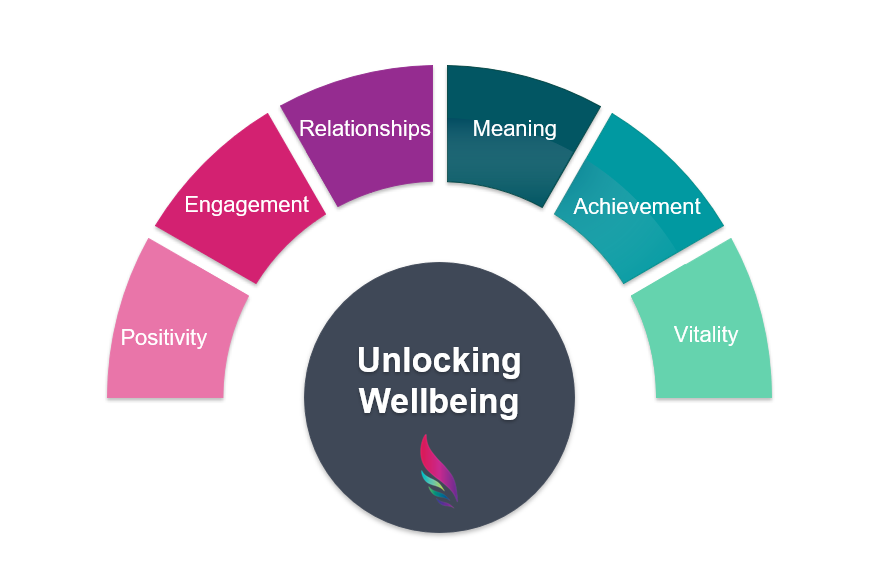
Unlocking Wellbeing: The Key to Employee Retention
In today’s fast-paced and competitive business landscape, organizations are increasingly recognizing the significance of employee wellbeing as a catalyst for enhanced retention rates and sustained employee engagement. As the old adage goes, “Happy employees are productive employees.” However, this isn’t just a sentiment; it’s grounded in the scientific principles of positive psychology (the science of wellbeing), particularly the PERMA-V model. By leveraging this framework to implement wellbeing initiatives, organizations can not only boost employee satisfaction but also fortify their workforce, leading to improved retention rates and a flourishing organizational culture.
The PERMA-V model, a cornerstone of positive psychology developed by Martin Seligman, encapsulates five essential elements that contribute to a person’s overall wellbeing: Positive Emotions, Engagement, Relationships, Meaning, Achievement, and a sixth element, Vitality, later introduced by Emiliya Zhivotovskaya. When transposed to the workplace, this model serves as a blueprint for fostering an environment that not only supports employee wellbeing but also generates a profound impact on retention and other aspects around human resourcefulness.
Positive Emotions: Infusing Joy into the Workplace
Introducing positive emotions into the work environment can have a profound influence on employee morale and retention. Small gestures like recognizing accomplishments, celebrating milestones, and fostering a culture of appreciation create a positive atmosphere that encourages employees to invest their energy and loyalty into the organization. Incorporating resilience skill building programs, mindfulness sessions, and other engaging activities can further nurture these positive emotions, leading to a more satisfying work experience and heightened commitment to the organization’s mission.
Engagement: The Art of Immersive Work
Engagement, the second pillar of the PERMA-V model, revolves around engrossing employees in their tasks and roles. Organizations can harness this concept by aligning employees’ strengths with their responsibilities and providing opportunities for skill development. When individuals feel their talents are recognized and honed, their sense of purpose and commitment deepens, resulting in increased job satisfaction and a desire to stay and contribute.
Relationships: Cultivating Meaningful Connections
Building strong interpersonal relationships within the workplace can significantly impact employee wellbeing and retention. Encouraging teamwork, collaboration, and open communication fosters a sense of belonging, which in turn boosts job satisfaction and the willingness to stay with the organization. Implementing mentorship programs, team-building activities, and cross-functional projects can facilitate the creation of these meaningful connections, solidifying employees’ commitment to the organization.
Meaning and Accomplishment: Fueling Intrinsic Motivation
When employees find meaning in their work and experience a sense of accomplishment, they are more likely to remain engaged and loyal. Organizations can create a sense of purpose by aligning employees’ tasks with the organization’s values and overarching mission. Regular feedback and recognition for achievements further fuel intrinsic motivation, empowering employees to take pride in their contributions and view their work as a vital piece of the larger puzzle.
Vitality: Nurturing Physical and Mental Wellbeing
The final pillar of the PERMA-V model, vitality, emphasizes the importance of physical and mental health. Encouraging a healthy work-life balance, providing access to resources, and promoting mental health awareness initiatives can significantly impact employee wellbeing and retention. Organizations that prioritize the holistic health of their employees signal that their workforce is valued beyond their professional roles, leading to a higher level of satisfaction and commitment.
Does Investing in Wellbeing Impact Retention?
Implementing workplace strategies rooted in the PERMA-V model directly translates into enhanced employee engagement, satisfaction, and ultimately, retention. By fostering an environment that addresses employees’ emotional, intellectual, and physical needs, organizations create a virtuous cycle wherein employees are more likely to stay, invest their efforts, and contribute to the organization’s success.
In a world where the competition for top talent is fierce, investing in employee wellbeing is no longer a luxury—it’s a strategic imperative. Organizations that embrace the PERMA-V model and integrate its principles into their workplace strategies not only create a nurturing and supportive environment but also position themselves as employers of choice. As word spreads about an organization’s commitment to its employees’ overall wellbeing, it becomes a beacon that attracts and retains the best talent.
In conclusion, employee wellbeing is not merely a feel-good concept; it’s a proven driver of retention and engagement. The PERMA-V model offers a comprehensive framework for cultivating a work environment that nurtures positive emotions, engagement, relationships, meaning, accomplishment, and vitality. By embracing this model and implementing strategies that prioritize employee wellbeing, organizations can foster a culture of thriving individuals, leading to heightened job satisfaction, increased retention rates, and a brighter future for both employees and the organization.
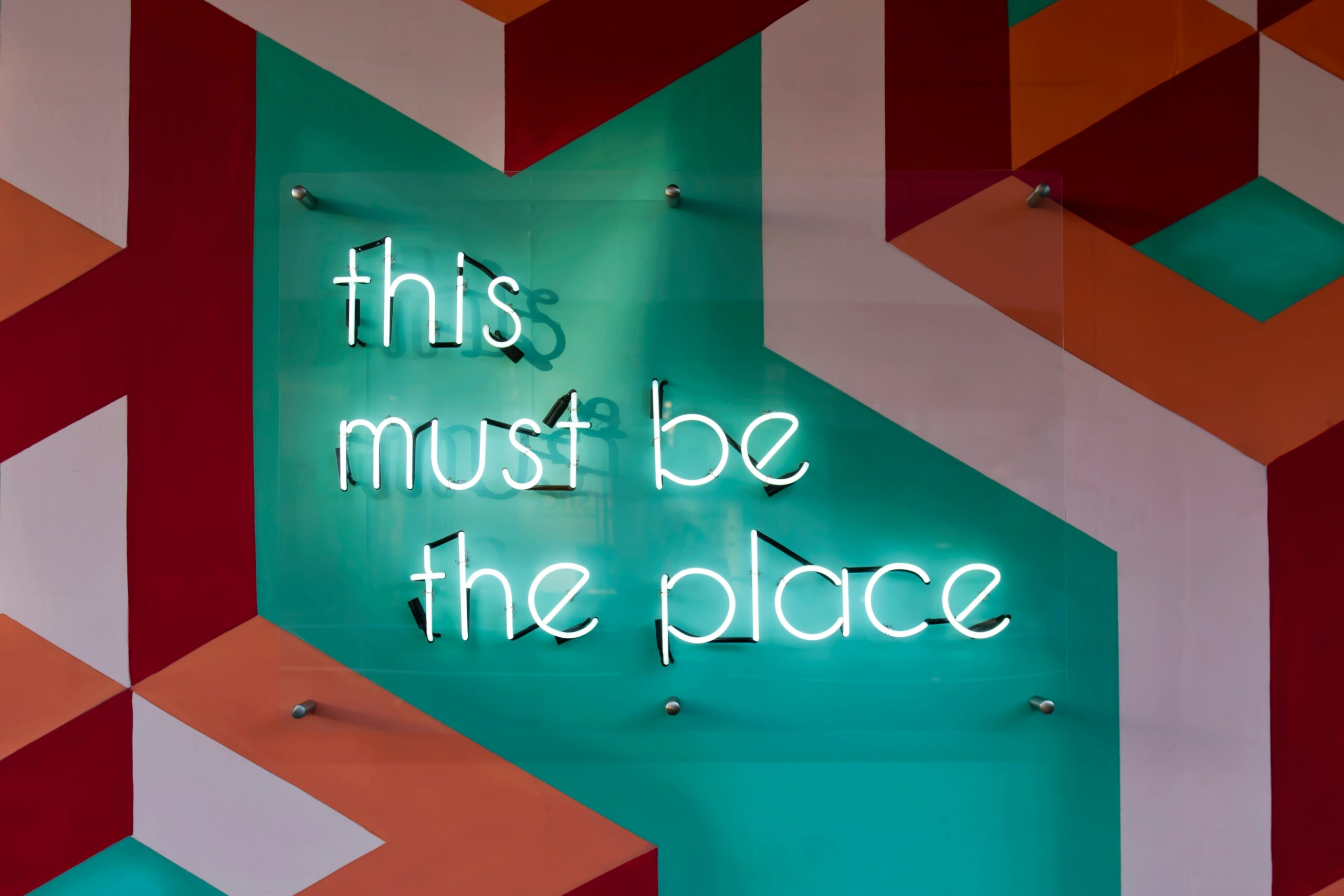
Building a Culture of Recognition and Reward
A 2022 Gallup poll found only 1 in 4 employees strongly agree they feel connected to their culture and only 1 in 3 strongly agree that they belong at their organization. The Harris Poll in 2023 found that more than one-third of Canadian companies (35%) said employee turnover had increased compared to the previous year, a significant rise from the 24% who said the same thing in 2021. This has become a big problem for employers and demonstrates a structural gap in the labour supply. There simply aren’t enough traditional employees to fill all the openings. Even when employers successfully woo these workers from rivals, they are just reshuffling talent and contributing to wage escalation while failing to solve the underlying structural imbalance.
We all know how critical the need is to keep our best employees, particularly since the recent worldwide pandemic. How often have you seen a top performer resign out of the blue, and management then relies on the remaining team members to take on more responsibility as they try to replace their colleague. This can be the tipping point that pushes more staff to leave and/or impacts employee morale.
What are the reasons why people leave? While we cannot always be sure, there are common categories such as:
- Personal Reasons: health, family issues, career changes
- Work-life balance: Challenges with rigid schedules, commutes, long hours
- Incompatibility: This often happens when the hiring process isn’t done well
- Work relationships: Conflict with co-workers or leadership
- Lack of opportunity
- Financial reasons: Better pay and benefits available elsewhere
- How can employers build effective retention strategies?
According to Robert Half, there are several things we can do to boost job satisfaction and retain talent. It starts at the beginning with proper onboarding and introduction to the employee culture. The new staff is set up for success when they have a mentor to help them learn and grow. Compensation is still an important factor and includes pension and benefits, but adding perks like flexible schedules, and remote work options are key factors post-pandemic. I have noticed that Gen Z and millennials want flexibility and remote work options, but are also keenly interested in wellness offerings. The shift to hybrid and remote work has highlighted the need for frequent and effective communication, as well as continuous feedback on performance.
Lastly, I truly believe recognition and reward systems go a long way in building and maintaining healthy workplace cultures and ultimately retaining staff. Listen, people need to know they are more than just a number or an employee, that you value them as people too!


For Municipalities, Retention Starts With Recruitment
The true beginning of the retention formula and strategy starts with recruiting. Most organizations think recruitment and turnover are two very different things, but they are actually the beginning and end to the same journey. Some talent remains loyal and committed for decades, while others quit within a few months of starting. If an organization decides to take shortcuts during the recruitment process, this results in an unstable foundational relationship with a candidate. So how does recruiting impact retention?
The Candidate and Employee Experience.
The first step for building a strong recruiting to retain strategy is to focus on the experience. This refers to both the candidate and the employee experience. The candidate experience is all about the hiring process and treatment of a candidate including:
- How quickly applicants receive a response to their resume submissions, questions and follow-up
- How personable management and leadership is during the interview process
- The logistics and efficiency for how interviews are conducted
Each and every interaction has a major impact. The candidate experience is the sum of the candidates’ thoughts, notions, and opinions about your organization, procedures, and the people they’ve talked to – and this judgment is formed even before they are hired. Most job seekers and candidates are frustrated by the length of the process, demands made of them, and the steps they’re obligated to take.
On the other hand, the employee experience is what an employee learns, sees, and hears from the company after they are hired. The experience takes place from their first company interaction through to their last goodbye. There are a variety of factors that may tempt your employees to look elsewhere for a new opportunity, and the candidate experience your competitor is providing can be a differentiating factor in their decision-making process.
Approaching Hiring With A Fit-First Approach
A “Fit First” recruiting strategy refers to an organization filling in the gaps of their current workforce or team instead of hiring for sameness. It’s about harnessing the power of diverse teams to achieve better outcomes, less groupthink, more innovative solutions and all around better performance. A team of people who excel at seeing “the big picture,” for example, may fail because they lack the individuals that can focus on details. If your Municipality or Broader Public Sector organization wants to achieve aggressive goals or become more innovative, it’s going to take new and novel perspectives to get there.
Municipalities can do this by adapting their overall hiring and retention strategy to be more competitive and stand out. Offering remote work allows employers to increase their talent pool, potentially lowering labor costs and opening up positions to a greater number of workers across the country. In some cases where remote work isn’t a viable option, Municipalities can pivot to offer flexible work options such as compressed workweeks or summer Fridays.
Keeping Talent Engaged
Employee turnover has been a major issue for the Public Sector over the past two years. While hiring professionals rank compensation as the top priority for job seekers, more often than not the candidates I speak with say they’re even more interested in opportunities for career advancement. While some Municipalities are eager to bring everyone back into the office, this can be a dealbreaker for some employees. If your key hires remained with you throughout the pandemic, you have done a great job keeping your teams and employees happy and feeling valued. But even still, Municipalities and Public Sector organizations need to continue building and creating a workplace that your team and people want to be at which includes:
- Provide growth opportunities and clearly defined career paths
- Have the right tech and tools in place
- Empower and trust employees
- Be flexible on work arrangements
- Focus on convenience as an incentive
- Upskilling or leadership training
Successfully building a retention-based recruitment strategy requires an executive recruitment partner that can engage and grow with you. The future of recruitment for many Public Sector organizations will rely on much more than the job alone. In order to retain those high performers, Public Sector organizations need to broaden their perspective to actionably consider how they can create the right working environment for future and existing employees.

7-Key Recruitment Strategies to Improve Retention
Employee retention begins long before the first day on the job. It starts during the recruitment process. A robust recruitment strategy not only ensures the right hire but also significantly impacts how long they stay. Though 80% of talent acquisition leaders recognize this, only half utilize analytics in their recruitment. Here’s a breakdown of seven strategies focused on refining recruitment to enhance retention.
1. Quality of Hire: The Heart of Retention
At the core of retention lies one performance metric: Quality of Hire. To significantly enhance employee longevity:
- Time to Productivity: Shorter integration periods often correlate with longer stays.
- Retention Rates & Performance Metrics: Combine longevity with performance to get a real measure of hiring quality.
- Employee Engagement: High engagement levels typically mean longer employee stays. Use periodic surveys to check and maintain engagement levels.
2. Candidate Experience: Laying a Foundation for Loyalty
A positive recruitment experience sets the tone for an employee’s journey. Clear communication about roles, feedback times, and company culture can be the first step towards a long-lasting relationship.
3. Embrace Automation: Enhancing Experience & Efficiency
Automated recruitment processes like online interviews, 24/7 chatbots, and swift screenings not only streamline operations but also reduce candidate wait times, improving their experience and, in turn, their inclination to stay.
4. Balancing Personality with Skills: For Long-Term Compatibility
While hard skills are teachable, soft skills like adaptability, teamwork, and communication often determine how well an employee fits in and, hence, how long they’ll stay. Use pre-employment tests to ensure a holistic match.
5. Continuous Improvement: Using Metrics to Enhance Retention
Gather data to refine your process. Identify trends in retention to:
- Understand which recruitment channels yield long-staying employees.
- Determine which roles or departments face higher turnover and why.
- Adjust recruitment strategies based on feedback and performance trends.
6. Onboarding: The Crucial First Impression
Retention is significantly influenced by an employee’s initial experiences. A comprehensive onboarding process that integrates, educates, and makes the employee feel valued can lay the foundation for years of loyalty.
7. Building Rapport: A Continuous Journey
Each interaction, from the first email to the final onboarding session, is an opportunity to build trust. Being approachable, transparent, and friendly during recruitment can set the tone for a long, fruitful relationship.
Retention Reflects your Recruitment Process
By focusing on the quality of hire, candidate experience, and continuous improvement, companies can significantly enhance employee loyalty.
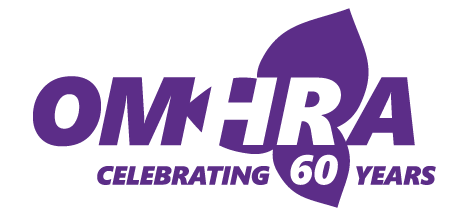
Table of Contents
- 1
- 2
- 3
- 4
- 5
- 6
- 7
- 8


